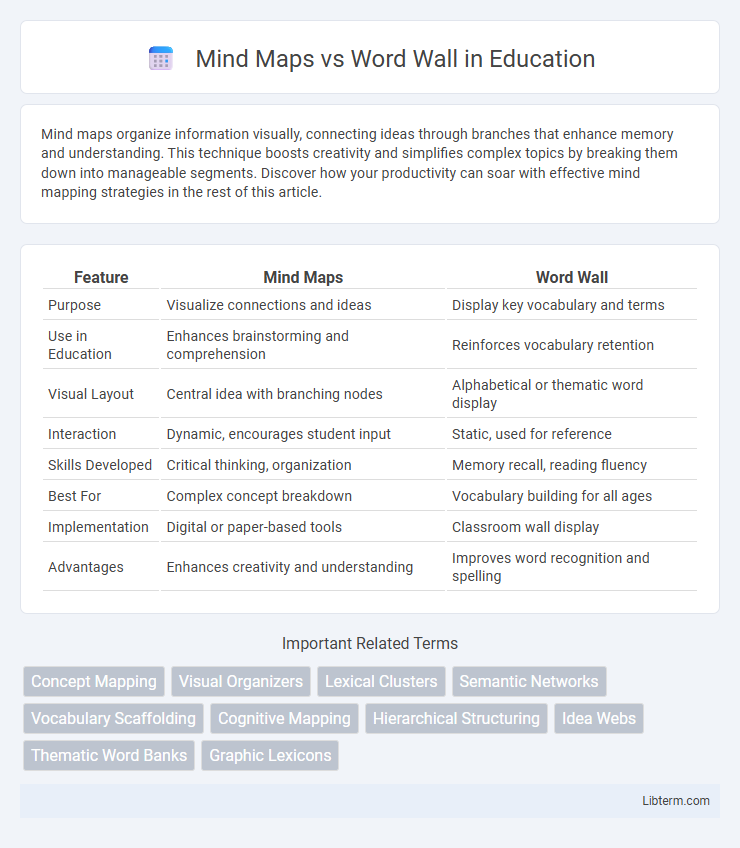Mind maps organize information visually, connecting ideas through branches that enhance memory and understanding. This technique boosts creativity and simplifies complex topics by breaking them down into manageable segments. Discover how your productivity can soar with effective mind mapping strategies in the rest of this article.
Table of Comparison
| Feature | Mind Maps | Word Wall |
|---|---|---|
| Purpose | Visualize connections and ideas | Display key vocabulary and terms |
| Use in Education | Enhances brainstorming and comprehension | Reinforces vocabulary retention |
| Visual Layout | Central idea with branching nodes | Alphabetical or thematic word display |
| Interaction | Dynamic, encourages student input | Static, used for reference |
| Skills Developed | Critical thinking, organization | Memory recall, reading fluency |
| Best For | Complex concept breakdown | Vocabulary building for all ages |
| Implementation | Digital or paper-based tools | Classroom wall display |
| Advantages | Enhances creativity and understanding | Improves word recognition and spelling |
Introduction to Mind Maps and Word Walls
Mind maps are visual tools that organize information hierarchically, using nodes and branches to represent concepts and their relationships, enhancing memory retention and idea generation. Word walls display key vocabulary prominently on classroom walls, supporting language acquisition and reinforcing word recognition through constant visual exposure. Both strategies foster active learning but serve distinct purposes: mind maps facilitate free-form idea exploration while word walls emphasize vocabulary building.
Defining Mind Maps: Structure and Purpose
Mind maps organize information visually through a central idea connected to branches representing related concepts, enhancing memory retention and brainstorming. They leverage associative thinking by linking keywords, images, and colors, which aids comprehension and creativity. Unlike word walls that list vocabulary terms, mind maps emphasize hierarchical relationships and interconnectedness within a topic.
What is a Word Wall? Key Features and Uses
A Word Wall is an organized display of vocabulary words prominently positioned in a classroom to reinforce language learning and comprehension. Key features include categorization by themes or word types, interactive elements to encourage student participation, and a visual reference that supports spelling and word recognition. Word Walls are commonly used to enhance literacy skills, facilitate word recall, and provide a constant resource for students during reading and writing activities.
Visual Learning: Mind Maps vs Word Walls
Mind maps enhance visual learning by organizing information hierarchically with branches and keywords, facilitating memory retention through spatial relationships and color coding. Word walls provide a constant visual reference of vocabulary, boosting language acquisition by displaying words in an accessible, categorized format that supports quick recall. Both tools leverage visual stimuli but mind maps excel in conceptual connections, whereas word walls emphasize recognition and reinforcement of specific terms.
Cognitive Benefits of Mind Mapping
Mind mapping enhances cognitive function by promoting better memory retention through visual organization of information, activating both hemispheres of the brain. It encourages creative thinking and problem-solving by allowing users to establish connections between concepts in a nonlinear format. Compared to word walls, mind maps provide a dynamic and flexible structure that supports deeper understanding and improved information recall.
Enhancing Vocabulary with Word Walls
Word Walls provide a visual and interactive method for enhancing vocabulary by displaying key terms in a consistent, accessible format that reinforces word recognition and usage. Unlike Mind Maps, which organize words in relational clusters to explore connections, Word Walls emphasize repetition and visibility, aiding retention through frequent exposure. This tool is especially effective in classrooms for supporting language development, vocabulary acquisition, and spelling skills.
Classroom Applications: When to Use Each Tool
Mind maps enhance brainstorming and organization by visually connecting ideas, making them ideal for complex subjects or project planning in classrooms. Word walls support vocabulary retention and language development by displaying key terms, benefiting early literacy and language learners. Use mind maps for exploring relationships among concepts, while word walls work best for reinforcing terminology and quick reference.
Mind Maps vs Word Walls: Pros and Cons
Mind maps enhance creativity by visually organizing ideas, making complex information easier to understand and recall, but they can become cluttered with excessive details, reducing clarity. Word walls improve vocabulary retention and quick reference by displaying key terms prominently, yet they may limit deeper comprehension since they emphasize memorization over conceptual connections. Both tools serve distinct educational purposes, with mind maps fostering analytical thinking and word walls supporting language acquisition.
Integrating Both Tools for Effective Learning
Integrating Mind Maps and Word Walls enhances learning by combining visual organization with vocabulary reinforcement, promoting deeper comprehension and retention. Mind Maps facilitate the connections between concepts and ideas, while Word Walls provide constant exposure to key terms, supporting memory and contextual understanding. Using both tools together in classrooms fosters interactive and multisensory learning environments, boosting student engagement and academic success.
Conclusion: Choosing the Right Tool for Your Needs
Selecting between Mind Maps and Word Walls depends on your learning objectives and content type. Mind Maps excel in organizing complex ideas visually, enhancing creativity and problem-solving, while Word Walls are effective for vocabulary retention and quick reference in language learning. Consider your goals: use Mind Maps for conceptual understanding and Word Walls for reinforcing key terms and definitions.
Mind Maps Infographic

 libterm.com
libterm.com